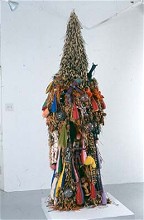
We took a cab to Harlem and back. Maybe that’s not such a big deal to you. But Roberta and me, we either walk or take the subway. We’re big on being democrats and fighting overuse of cars (image, Nick Cave’s “Sound Suit”).
But we wanted to get from Chelsea to Harlem and back and save every second we could.
Plus–and here’s the point that weighed most heavily–there were four of us to split the fare, or, to put it another way, there were four of us to pay the subway fares, or to put it still another way, there were four of us to divide the cab’s pollution quotient.
The Studio Museum in Harlem once again put on a great show, “Frequency.” This large group exhibit of 35 black emerging artists from New York to Los Angeles, was co-curated by Thelma Golden and Christine Y. Kim. Goldin, SMH’s director and chief curator, and Kim, SMH’s associate curator, once again showed what savvy observers they are of what’s happening in the art world and what’s good.
I’m going to put up a few of my favorites in the show and Roberta will put up some of hers and my guess is we’ll overlap a bit. I also want to add that we were too tired to engage with the hour’s worth of videos by time we’d gone through the rest of the show, so they may have been good, even great, but I can’t say one way or the other.
There was a lot in this show about the roles of fabric and clothes. So those are the pieces I’m going to stick to.
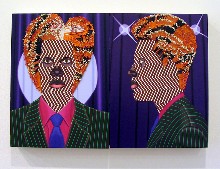
This show tended toward the hand made, the non-computer mediated. And New York artist Jeff Sonhouse opened the show with two knockout pieces, my favorite (not pictured), being the iconic “Exhibit A: Cardinal Francis Arinze,” an oil painting of someone dressed as a cardinal with a 3-D chaircoal briquette rosarie around his neck. The wooden throne, the drapery colors, the purple velvet ropes, the draped hands with a large ring, I loved every bit. We first told you about work by this artist in May, here. Sonhouse, who paints faces masked by balaclava helmets, uses a mix of paint and 3-D materials to create bright fabric-print inspired images with wicked anger. (image, “Inauguration of the Solicitor,” includes match sticks for hair).
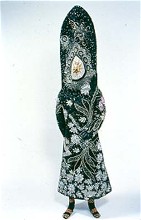
On the subject of faceless faces, Chicago artist Nick Cave’s “Sound Suit” series gave a dark, edginess to gorgeous outfits with pointy headcovers that suggested recapturing power from the Ku Klux Klan (those guys didn’t have much power, really, but they used masks to exaggerate what they had). At the same time, the pieces remind me of the shape-shifting dancers featured in the Africa show at the Philadelphia Museum of Art. But these headcovers have no holes whatsoever. And the outfits are encrusted with beads, sequens, metallic embroidery and crewel, all of it from found beaded and sequined garments. Is this about listening to block out the world? Is it a good thing? A bad thing? Beats me. But the fabric is glorious, the trope of encased heads scary (image, “Sound Suit”, part of the same series as the image as the top).
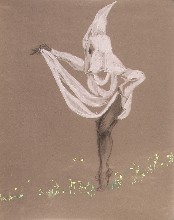
And while I’m on the subject of the Klan, Zoe Charlton’s peek-a-boo drawings of women wearing Klan robes as negliges are full of skewering ironies. Charlton, who lives in Baltimore, mixes naughty and nice at the same time that she raises spectres of women’s roles as African Americans. And not afraid of a little undermining her nice-girl subjects, she lets one of them fart her way forward undersail, the sails flying off little masts on her back like panties off a clothesline (image, “Tip Toe” from the Undercover series).
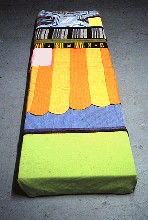
Clothes and fabric themes in this show reflect our preoccupations and African American preoccupations with them. Rashawn Griffin’s untitled portrait of fabric and clothes wrapped around a foam pallet on the floor offers a provocative mix of thoughts on homelessness, growing up and taste. I especially liked the Star Wars sheets covering where the head would go, maybe because my 27-year-old son still loves Star Wars, or maybe because it undercuts the mutually contradictory suggestions in the piece provided by the corporate necktie and the striped afghan/cape.
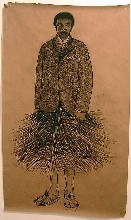
And while I’m on the subject of corporate or societally “correct” vs. free and clothes making the man or woman, Robert Pruitt’s fabulous conte crayon drawings of people expressing conflicted identities and societal ambivalence are both beautiful and surprising. Pruitt, who lives and works in Houston, uses a variety of means to suggest that we are not whom we seem, by calling up tribal imagery. In “Pretty for a Black Girl,” he tops a bikini-clad beauty with an African mask and breastplate that reminded me of Star Trek Ferengis, and “CEO Portrait” gives the suit-jacketed leader an aerodynamic tribal skirt, its curled up edges suggesting plumage (image, “CEO Portrait” from the Talented 10th Series).
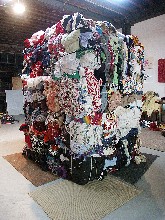
On clothes as a subject of trade, waste, recycling, as a symbol of haves and have-nots around the globe, Shinique Amie Smith’s bales of clothes serve as icons of the international economic order (image, “Bale Variant No. 0006). And holding the fort for trompe l’oeil painting, Sedrick Huckaby’s enormous “A Love Supreme Summer” (oil, 94″ x 240″) offers a variety of utilitarian quilts hanging like life-size drapes, a sentimental homage to the fabric as well as to the medium and the season.
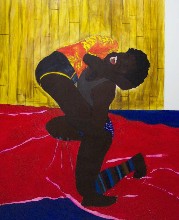
Mickalene Thomas, who by the way is a Camden, N.J. native, now working in Brooklyn, makes fabric trimmings and rhinestones the material of her work, and in this she is not all that dissimilar from Nick Cave and Jeff Sonhouse. But her results and subject matter cut at different edges. She’s got the lesbian wrestler/roller-derby/wwf babe thing going on here, her clinched subjects either or both in the midst of a knock-down wrestle or very hot sex amidst voluptuous fabrics. The flatness, the pared down settings, and the voluptuous tangles on the floor come straight out of Japanese woodblock prints. But the pieces also remind me of the cheesy commercial pictures of gods in Indian and Thai restaurants. So I hardly know whether I love them or reject them outright — I love being on this edge of not knowing, because it makes me think some more (image, “Instant Gratification” from the Brawling Spitfire series).
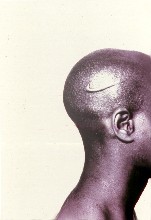
In photography, the iconic “Nike” by Hank Willis Thomas, the brand symbol branded on a shaved head against a white photo backdrop recalls the s&m and exploitation vibe of Robert Mapplethorpe, especially his black subjects, even as it brings up issues of slavery, ownership, scarification and the sorry commercialism of sports. That white backdrop also brings up Ralph Lauren and fashion. What a photo! His piece, “Liberation of T.O.: Ain’t no way I’m go’n in back ta’work fa’massa in dat darn field,” shows footballer Terrell Owens scattering people and wares in his wake as he escapes, football in hand, down a city street. Although I think the guy is a nut case, I do think he felt the corporate unity of Eagles management was like working for the massa, and this photo captures that feeling perfectly (image, “Branded Head”).
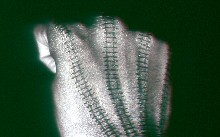
The other hot photographer was Demetrius Oliver, whose tongue isn’t always planted as firmly in his cheek as his picture of curly black hair emerging from an ear suggests. “Tracks” drawn on a the back of a fisted hand stayed open even as it suggested underground railroad, and classroom tracking and drug tracks and anger. Both of these photos reminded me of body photographer John Coplans, the detail of the body parts so resolved as to become something more.

Oops, I’m straying from my subject. Here’s a list of other stuff I liked that weren’t really about fabric or clothes: Philadelphia artist Jina Valentine’s takes on the evanescence of culture and lives; Roberto Visani’s dark sculptural takes on African American poverty and lifestyle; Paula Wilson’s use of video in the middle of a painting; Mark Andre Robinson’s mixture of power and delicacy and suggestion in charcoal on paper (shown); Jefferson Pinder’s “Invisible Man” and, with Jeff Stein, “Carwash Meditations” videos; Leslie Hewitt’s memory photocollages, “riffs on real time;” Michael Paul Britto’s poster for his video “Dirrrty Harriet Tubman”; and Nyame O. Brown’s delicate drawings on monsterhood and its powers to engender fear (image, Mark Andre Robinson, untitled from “Crusade Fragments” series).









